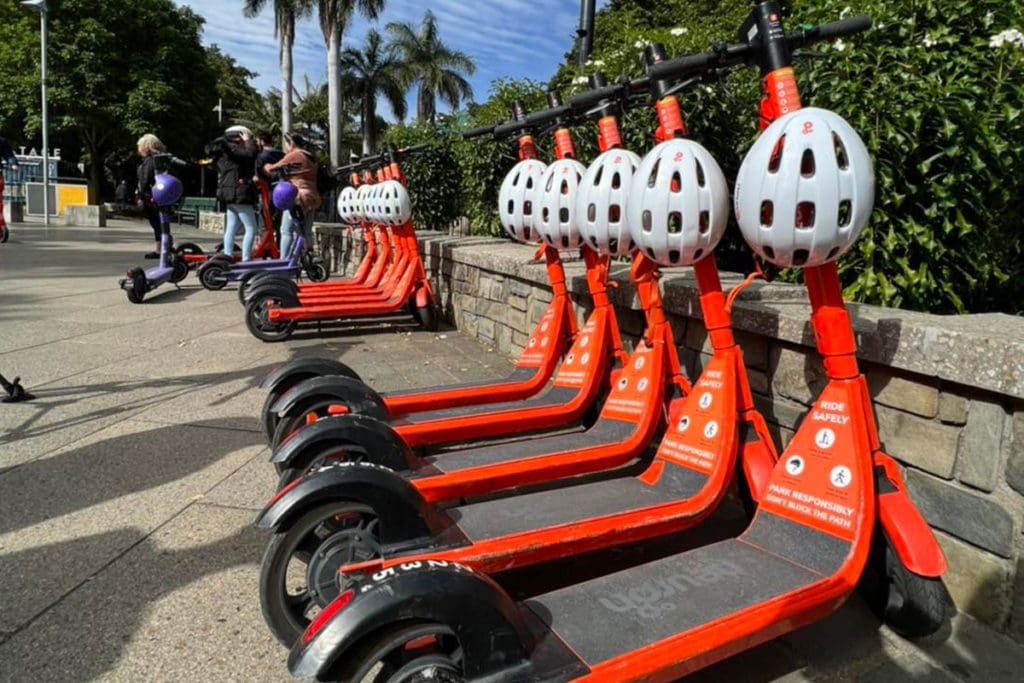Scooter Companies Welcome Government Strategy to Declutter Paths

Brisbane, Queensland
An e-Mobility Parking Plan has been launched by the Queensland Government to address the ‘clutter’ of e-scooters and other e-mobility devices on the State’s paths.
The plan aims to improve the parking of e-scooters, e-bikes and other e-mobility devices “to ensure they are not left in a way which blocks paths and creates safety and amenity issues for other path users”, according to a statement by the government.
Transport and Main Roads Minister Mark Bailey said it was time to clean up our paths to create a more inclusive and accessible environment.
“E-Scooters are a great way to get around, but too often I see them left in locations blocking paths which creates significant problems for people walking – especially those with limited mobility,” Mr Bailey said.
“I have had to move badly parked e-scooters out of the way on several occasions, which some people cannot do, like people who use wheelchairs and those with vision impairments.
“For them, it’s more than a minor inconvenience. It can mean adding significant time to a trip to detour around a misplaced e-scooter.
“I urge Queenslanders to keep our footpaths and thoroughfares clear so every person can walk, ride and scoot freely.”
Minister Bailey said the e-Mobility Parking Plan was developed by Transport and Main Roads in partnership with the e-mobility Parking Working Group, which includes representation from local councils and industry as well as disability and road users advocacy organisations.
Beam Response
Share scooter provider Beam Mobility Australia welcomed the Government’s plan and commitment to action on Personal Mobility Device (PMD).
“Beam has already implemented a number of the measures outlined in the strategy as part of the State’s e-Mobility Parking Working Group, following months of engagement with Transport and Main Roads, local councils and disability advocates across the State,” Beam said in a statement.
The company’s Head of Policy (ANZ), Sarah Taylor, said: “We have always expected riders to ensure their PMD it out of the way of pedestrians. We run checks to ensure this and issue fines for non-compliance.”
“We recognise the difficulties facing those with strollers or those with a disability when navigating around poor parkers and have an extensive response team on the ground to relocate devices when they are reported to be in the way.”
Beam is supportive of all measures outlined under the e-Mobility Parking Plan, including:
- The expansion of designated e-mobility parking areas, like those popping up around the inner city
- Supporting better reporting of poor parking, especially to e-scooter providers
- Investigating regulation, including potential fines for those who improperly park a hire e-scooter
- Improved communication and education
Tactile Signage Trial
In addition to Beam’s work with the state working group, Beam has also launched a trial of tactile signage across Brisbane from this month to allow people with impaired vision to better identify e-scooters and report issues such as badly parked e-scooters.
The signage features yellow raised lettering with the words “In the way? Scan” with an accompanying QR code.
Scanning the QR code leads the reporter to a ‘Report a Beam’ form with the vehicle number of the corresponding vehicle automatically filled in. The submitted form alerts Beam Rapid Response Rangers who relocate the vehicle to a suitable parking space.
“The tactile signage was designed in consultation with blind low vision community groups across Australia and New Zealand,” Sarah said
“We have tested it with a group of stakeholders in the development stage, and have rolled out a trial across selected cities to gain broader public feedback. Following this trial, we will assess how it can be scaled further across the fleet.”
Neuron Response
Another scooter share provider and active member of the working group, Neuron Mobility, said it is continuing to work with its safety partners in this country, Blind Citizens Australia and the Australian Road Safety Foundation, to educate riders on riding and parking responsibly.
It recently held a Global Road Safety Week in collaboration with the two partners and continued to run dedicated safety campaigns in many cities, include rider education materials, in-person ScootSafe events and series of videos that encourage viewers to be mindful of their surroundings and be considerate of pedestrians, especially wheelchair users, the elderly and people with impaired vision.
Earlier this year, Neuron launched the ScootSafe Academy digital education platform, including city-specific safety materials and targeted training modules for riders who have broken the rules.
Moggill Road Route Upgrade
The Queensland Government is also calling for community feedback on plans to improve active transport routes along Brisbane’s Moggill Road.
Community input is invited by 15th January.
The study area is divided into three sections:
- Section 1: from the Centenary Motorway (including Centenary Cycleway) to the intersection of Moggill Road and Chapel Hill Road
- Section 2: from the intersection of Moggill Road and Chapel Hill Road to the intersection of Moggill Road and Kilkivan Avenue just south of the Kenmore Roundabout
- Section 3: from the corner of Moggill Road and Kilkivan Avenue through to the intersection of Moggill Road and Rafting Ground Road.
